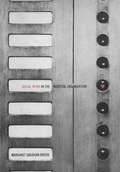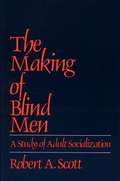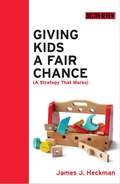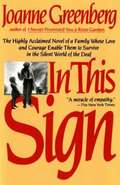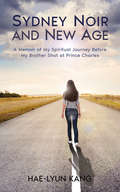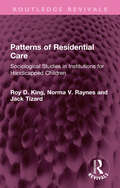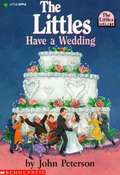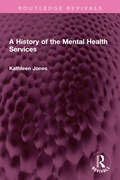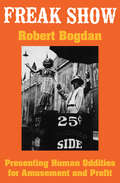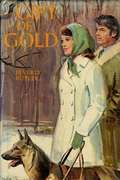- Table View
- List View
Come Back, Wherever You Are (Beany Malone Series, #14)
by Lenora Mattingly WeberBeany is thrilled to hear that her childhood friend Kay and her family are coming back to town. Now married with two small children, Beany looks forward to girl talk and playing with Kay's small son Jodey. When Kay arrives, Beany learns that she is very ill and that Jodey has been abused and is so frightened of people that he hides or runs away. She opens her heart and home to this little boy, hoping that love and acceptance can heal him.
Counterclockwise
by Mary Jane WardSusan Wood is the author of the novel Hideaway which was made into a popular movie; the novel was based on her experiences as a psychiatric patient in a state hospital. She is in great demand as a speaker on the conditions faced by the mentally ill, and she serves on the board of a mental health foundation. During a tour of a state hospital during one of her speaking engagements she visits the infamous Ward 10A and is swept into another breakdown. Finding herself hospitalized once more, this time in a private facility, she struggles to make sense of the world and get her life back on track. The story is enlivened by an assortment of fellow patients and an eccentric but determined nurse who deals cards counterclockwise.
Goldie, The Story of a Guide Dog
by J. J. ProwseWhen Betty and Terry meet Mr. Write and his beautiful labrador Bella in the park, and learn about what a guide dog can do, they decide to donate their puppy Goldie to the Royal Guide Dogs Association in Australia. The following year, they raise Goldie to be a guide dog, and train Prince another pup. At the same time Dave Stewart a young man in their town, applies to get a guide dog after loosing his sight in a fire. Fate seems to be in the cards as he is matched with Goldie. This is the story of Goldie's training, her process of testing, puppy raising, training, and working with David, and Terry and Betty's love and experiences as puppy walkers.
Manual for the Stanford Multi Modality Imagery Test
by William L. DautermanThe author's data on the test called "The Stanford Multi-Modality Imagery Test for the Blind" as a part of a research project has been revised in this manual under the name of "The Stanford Multi-Modality Imagery Test."
Perceptual Factors in Braille Word Recognition
by Carson Y. Nolan Cleves J. KederisThis monograph presents the findings of several years of study of the braille system as a communication process.
Social Work in the Hospital Organization
by Margaret Gaughan BrockThis book was written to fill a need for a basic text about medical social work. The material has specific reference to social work in the hospital organization, but much of it is applicable to social work within the broader context of health care.Any printed material now available on the subject is largely incidental and scattered reference. This book will be of great value to social workers, and to students in hospital administration, medicine, and nursing. It will also be of help to members of hospital boards and to hospital administrators who wish to establish or evaluate a social service department.Beginning with a background in the history of the hospital and social work, the book provides chapters on the role and function of a social service department in a hospital, on the staffing and administration of such a department, on the kinds of activity in which it engages, and on its place in the larger organization of which it is a part.
Stolen Pony
by Glen Rounds(from the book jacket): Stolen! Locked in a swaying truck, the little blind pony snorts with terror. Horse thieves captured him in the dead of night. And now he is being carried farther and farther from home. What will happen when the thieves find out he is blind? Will they turn him loose? But how can a blind pony find his way home?
The Making Of Blind Men
by Robert A. Scott<P>The disability of blindness is a learned social role. The various attitudes and patterns of behavior that characterize people who are blind are not inherent in their condition but, rather, are acquired through ordinary processes of social learning. The Making of Blind Men is intended as a systematic and integrated overview of the blindness problem in America. <P> Dr. Scott chronicles which aspects of this problem are being dealt with by organizations for the blind and the effectiveness of this intervention system. He details the potential consequences of blind people becoming clients of blindness agencies by pointing out that many of the attitudes, behavior patterns, and qualities of character that have been assumed to be given to blind people by their condition are, in fact, products of socialization. As the self-concepts of blind men are generated by the same processes of socialization that shape us all, <P>Dr. Scott puts forth the challenge of reforming the organized intervention system by critically evaluating the validity of blindness workers' assumptions about blindness and the blind. It is felt that an enlightened work force can then render the socialization process of the blind into a rational and deliberate force for positive change.
The Prison of My Mind
by Barbara Field BenzigerIn this memoir of psychiatric illness, the author describes two hospitalizations and her eventual restoration to mental health. In the first hospital she receives indifferent and even abusive treatment. In the second she has the good fortune to be assigned to a wise and compassionate psychiatrist who helps her explore her inner conflicts and find peace. Benziger writes eloquently of the terror of severe panic attacks when the world seems to be collapsing around her.
Giving Kids a Fair Chance
by James J. HeckmanIn Giving Kids a Fair Chance, Nobel Prize-winning economist JamesHeckman argues that the accident of birth is the greatest source of inequality in America today. Children born into disadvantage are, by the time they start kindergarten, already at risk ofdropping out of school, teen pregnancy, crime, and a lifetime of low-wage work. This is bad for allthose born into disadvantage and bad for American society. Current social andeducation policies directed toward children focus on improving cognition, yet success in liferequires more than smarts. Heckman calls for a refocus of social policy toward early childhoodinterventions designed to enhance both cognitive abilities and such non-cognitive skills asconfidence and perseverance. This new focus on preschool intervention would emphasize improving theearly environments of disadvantaged children and increasing the quality of parenting whilerespecting the primacy of the family and America's cultural diversity. Heckmanshows that acting early has much greater positive economic and social impact than laterinterventions -- which range from reduced pupil-teacher ratios to adult literacy programs toexpenditures on police -- that draw the most attention in the public policy debate. At a time whenstate and local budgets for early interventions are being cut, Heckman issues an urgent call foraction and offers some practical steps for how to design and pay for newprograms. The debate that follows delves deeply into some of the most fraughtquestions of our time: the sources of inequality, the role of schools in solving social problems,and how to invest public resources most effectively. Mike Rose, Geoffrey Canada, Charles Murray,Carol Dweck, Annette Lareau, and other prominent experts participate.
Honey Out of Stone
by Gary AdelmanGary Adelman has written intensely about a man's rediscovery of life within the affliction of unexpected blindness. Attacked by diabetes-induced blindness, Ben Storch abides the despair attendant upon the dissolution of his marriage and the spiritual terror of darkness. It is an "unblinding" through love--the love of a childhood sweetheart who leaves her own unhappy marriage to come to him--that gives his life an unhoped-for new meaning. Adelman tells Storch's story in a blend of prose and poetry which ranges from lyric and tender to violent and grotesque. He captures the heartbreak of loss and then the exhilaration of spiritual rebirth. But the essence of the book is his lyric, sexual, and wildly exuberant celebration of the romantic love, which has brought him new joy, new strength and vision.
In This Sign
by Joanne GreenbergJanice and Abel are a deaf couple. Their daughter can hear, and becomes their interpreter from a very early age. The parents are ashamed of their sign language and won't sign in public, only at the deaf club or with deaf friends. The daughter is interpreting phone calls, medical and banking appointments, legal and other situations long before she understands them. This is a historical novel, of a deaf world that no longer exists, but is accurate for its time.
Sydney Noir and New Age: A Memoir of My Spiritual Journey Before My Brother Shot at Prince Charles
by Hae-Lyun KangThis memoir is an exploration of past lives, rebirthing, astrology, numerology, of experiencing God, and of visiting South Korea and Japan before my brother shot at Prince Charles.
The Community of the Blind: Applying the Theory of Community Formation
by Yoon Hough KimDr. Kim has investigated the validity of the widely-held view that while there are a large number of blind persons whose social lives are centered in the mainstream, that is with sighted persons, there are an equally large number of blind persons whose social lives are restricted mainly to other blind persons.
The Social Sources of Adjustment to Blindness
by Irving Faber Lukoff Martin WhitemanThe impact of society on the blind is a complex issue, and many different tacks are necessary even if we are to only make little headway through the eddies and currents that alter and modify people's lives. This study is focused on the social forces that influence the adaptation of blind persons. The information derives from almost 500 interviews with blind persons selected from all walks of life.
Twink (formerly Touching)
by John NeufeldDoctors told Twink's mother how hopeless her daughter's case was. Her family had been warned of the awesome responsibility they were all accepting. Her "preppie" step-brother Harry felt sick the first time he saw her. But how could any of them give up on Twink or stop loving her--when she refused to give up either them or herself?
Art Not by Eye: The Previously Sighted Visually Impaired Adult in Fine Arts Programs
by Yasha LisencoThe book, in two parts, deal with avenues for adventitiously blind adult, and the blind and severely visually impaired adults in the art program.
Patterns of Residential Care: Sociological Studies in Institutions for Handicapped Children (Routledge Revivals)
by Jack Tizard Roy D. King Norma V. RaynesOriginally published in 1971, this title describes a series of studies dealing with the upbringing of children in residential institutions. Most work has been carried out in institutions for children with learning disabilities, although units caring for able but deprived children and children with physical disabilities have also been examined. The investigations have been concerned with the detailed nature of different institutional environments – that is, the routine patterns of daily life in hospital wards, hostels and cottages of children’s homes – rather than with the effects of specific child-rearing practices upon the intellectual, emotional and social development of the children. The more precise delineation of ‘the environment’ is an essential step towards the evaluation of residential services and the interpretation of their effects upon those who use them, yet this is an area which had received little systematic attention from social scientists at the time. This book is a re-issue originally published in 1971. The language used is a reflection of its era and no offence is meant by the Publishers to any reader by this re-publication.
The Littles Have a Wedding
by John PetersonMeet the Littles, a family like any other but with a few tiny differences! They live in the walls of the Bigg family house where they get everything they need. In return they make sure the Bigg house is always in good repair. When Dinky comes home from his latest adventure, he's not alone. Della came back with him and they're going to be married! But a tiny person wedding takes a huge amount of preparation. The Littles need to get everything ready and travel to a neighboring house by the next day. Will they be ready in time?
A History of the Mental Health Services: A Revised History Of The Mental Health Services - From The Early 18th Century To The 1990s (Routledge Revivals)
by Kathleen JonesFirst published in 1972, A History of the Mental Health Services is a revised and abridged version of both Lunacy, Law and Conscience and Mental Health and Social Policy, rewriting the material from the end of the Second World War to the passing of the Mental Health Act 1959, and adding a new section which runs from 1959 to the Social Services Act 1970. The story starts with the first legislative mention of the ‘furiously and dangerously mad’ as a class for whom some treatment should be provided, traces the development of reform and experiment in the nineteenth century, and the creation of the asylum system, and ends in the age of Goffman and Laing and Szasz with the virtual disappearance of the system. The book will be of interest to students of mental health, sociology, social policy, health policy and law.
Dogs Working for People
by Joanna FosterThis detailed book talks about the different ways dogs help or work for people. From hunting dogs, to Seeing Eye dogs, to dogs that sniff out bombs. With picture descriptions.
Freak Show: Presenting Human Oddities for Amusement and Profit
by Robert BogdanThis cultural history of the travelling freak show in America chronicles the rise and fall of the industry as attitudes about disability evolved.From 1840 until 1940, hundreds of freak shows crisscrossed the United States, from the smallest towns to the largest cities, exhibiting their casts of dwarfs, giants, Siamese twins, bearded ladies, savages, snake charmers, fire eaters, and other oddities. By today&’s standards such displays would be considered cruel and exploitative—the pornography of disability. Yet for one hundred years the freak show was widely accepted as one of America&’s most popular forms of entertainment. Robert Bogdan&’s fascinating social history brings to life the world of the freak show and explores the culture that nurtured and, later, abandoned it. In uncovering this neglected chapter of show business, he describes in detail the flimflam artistry behind the shows, the promoters and the audiences, and the gradual evolution of public opinion from awe to embarrassment. Freaks were not born, Bogdan reveals; they were manufactured by the amusement world, usually with the active participation of the freaks themselves. Many of the "human curiosities" found fame and fortune, until the ascent of professional medicine transformed them from marvels into pathological specimens.
From Anna
by Jean LittleAnna has always been the clumsy one in the family. Somehow she can never do anything right! She bumps into tables, and she can't read the blackboard at her school. Her perfect brothers and sisters call her "Awkward Anna." When Papa announces that the family is moving from Germany to Canada, Anna's heart sinks. How can she learn English when she can't even read German? Nothing could be worse than this! But when the Soldens arrive in Canada, Anna learns that there is a reason for her clumsiness. And suddenly, wonderfully, her whole world begins to change.
Gift of Gold
by Beverly Butler<P>When Cathy Wheeler decided to become a speech therapist, she faced more than ordinary problems. Cathy was blind, and her speech department chairman said she had chosen an unrealistic profession. Even with sight, controlling young patients would be difficult, and to depend on other senses to work successfully with children would take extraordinary talent and alertness. <P>But Cathy had courage--backed up by a golden dream. An eye doctor had said that part of her sight might be restored. Not only would resistance to her chosen career stop, but Cathy knew she would find it easier to make up her mind about Greg and Steve, the two very different men in her life. <P>But suppose the verdict at the final eye examination went against her? Cathy wondered if she would have the courage then to stand on her own two feet and prove that she could handle a career in speech therapy. How would it affect her feelings about Greg and Steve? How would they feel about her?
Independent Living Without Sight and Hearing
by Richard KinneyThis is a wonderful resource for blind-deaf individuals and those who interact with them. It covers such topics as communication methods, independence at home, telephones, travel hints and much more.

